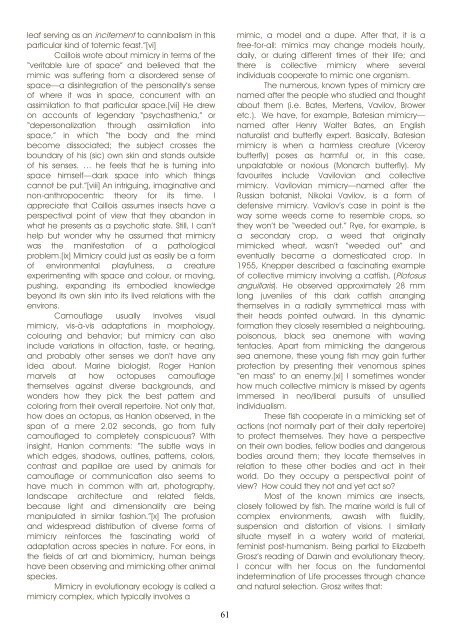Animal Influence I - Antennae The Journal of Nature in Visual Culture
Animal Influence I - Antennae The Journal of Nature in Visual Culture
Animal Influence I - Antennae The Journal of Nature in Visual Culture
You also want an ePaper? Increase the reach of your titles
YUMPU automatically turns print PDFs into web optimized ePapers that Google loves.
leaf serv<strong>in</strong>g as an <strong>in</strong>citement to cannibalism <strong>in</strong> this<br />
particular k<strong>in</strong>d <strong>of</strong> totemic feast.”[vi]<br />
Caillois wrote about mimicry <strong>in</strong> terms <strong>of</strong> the<br />
“veritable lure <strong>of</strong> space” and believed that the<br />
mimic was suffer<strong>in</strong>g from a disordered sense <strong>of</strong><br />
space—a dis<strong>in</strong>tegration <strong>of</strong> the personality’s sense<br />
<strong>of</strong> where it was <strong>in</strong> space, concurrent with an<br />
assimilation to that particular space.[vii] He drew<br />
on accounts <strong>of</strong> legendary “psychasthenia,” or<br />
“depersonalization through assimilation <strong>in</strong>to<br />
space,” <strong>in</strong> which “the body and the m<strong>in</strong>d<br />
become dissociated; the subject crosses the<br />
boundary <strong>of</strong> his (sic) own sk<strong>in</strong> and stands outside<br />
<strong>of</strong> his senses. … he feels that he is turn<strong>in</strong>g <strong>in</strong>to<br />
space himself—dark space <strong>in</strong>to which th<strong>in</strong>gs<br />
cannot be put.”[viii] An <strong>in</strong>trigu<strong>in</strong>g, imag<strong>in</strong>ative and<br />
non-anthropocentric theory for its time. I<br />
appreciate that Caillois assumes <strong>in</strong>sects have a<br />
perspectival po<strong>in</strong>t <strong>of</strong> view that they abandon <strong>in</strong><br />
what he presents as a psychotic state. Still, I can’t<br />
help but wonder why he assumed that mimicry<br />
was the manifestation <strong>of</strong> a pathological<br />
problem.[ix] Mimicry could just as easily be a form<br />
<strong>of</strong> environmental playfulness, a creature<br />
experiment<strong>in</strong>g with space and colour, or mov<strong>in</strong>g,<br />
push<strong>in</strong>g, expand<strong>in</strong>g its embodied knowledge<br />
beyond its own sk<strong>in</strong> <strong>in</strong>to its lived relations with the<br />
environs.<br />
Camouflage usually <strong>in</strong>volves visual<br />
mimicry, vis-à-vis adaptations <strong>in</strong> morphology,<br />
colour<strong>in</strong>g and behavior; but mimicry can also<br />
<strong>in</strong>clude variations <strong>in</strong> olfaction, taste, or hear<strong>in</strong>g,<br />
and probably other senses we don’t have any<br />
idea about. Mar<strong>in</strong>e biologist, Roger Hanlon<br />
marvels at how octopuses camouflage<br />
themselves aga<strong>in</strong>st diverse backgrounds, and<br />
wonders how they pick the best pattern and<br />
color<strong>in</strong>g from their overall repertoire. Not only that,<br />
how does an octopus, as Hanlon observed, <strong>in</strong> the<br />
span <strong>of</strong> a mere 2.02 seconds, go from fully<br />
camouflaged to completely conspicuous? With<br />
<strong>in</strong>sight, Hanlon comments: “<strong>The</strong> subtle ways <strong>in</strong><br />
which edges, shadows, outl<strong>in</strong>es, patterns, colors,<br />
contrast and papillae are used by animals for<br />
camouflage or communication also seems to<br />
have much <strong>in</strong> common with art, photography,<br />
landscape architecture and related fields,<br />
because light and dimensionality are be<strong>in</strong>g<br />
manipulated <strong>in</strong> similar fashion.”[x] <strong>The</strong> pr<strong>of</strong>usion<br />
and widespread distribution <strong>of</strong> diverse forms <strong>of</strong><br />
mimicry re<strong>in</strong>forces the fasc<strong>in</strong>at<strong>in</strong>g world <strong>of</strong><br />
adaptation across species <strong>in</strong> nature. For eons, <strong>in</strong><br />
the fields <strong>of</strong> art and biomimicry, human be<strong>in</strong>gs<br />
have been observ<strong>in</strong>g and mimick<strong>in</strong>g other animal<br />
species.<br />
Mimicry <strong>in</strong> evolutionary ecology is called a<br />
mimicry complex, which typically <strong>in</strong>volves a<br />
61<br />
mimic, a model and a dupe. After that, it is a<br />
free-for-all: mimics may change models hourly,<br />
daily, or dur<strong>in</strong>g different times <strong>of</strong> their life; and<br />
there is collective mimicry where several<br />
<strong>in</strong>dividuals cooperate to mimic one organism.<br />
<strong>The</strong> numerous, known types <strong>of</strong> mimicry are<br />
named after the people who studied and thought<br />
about them (i.e. Bates, Mertens, Vavilov, Brower<br />
etc.). We have, for example, Batesian mimicry—<br />
named after Henry Walter Bates, an English<br />
naturalist and butterfly expert. Basically, Batesian<br />
mimicry is when a harmless creature (Viceroy<br />
butterfly) poses as harmful or, <strong>in</strong> this case,<br />
unpalatable or noxious (Monarch butterfly). My<br />
favourites <strong>in</strong>clude Vavilovian and collective<br />
mimicry. Vavilovian mimicry—named after the<br />
Russian botanist, Nikolai Vavilov, is a form <strong>of</strong><br />
defensive mimicry. Vavilov’s case <strong>in</strong> po<strong>in</strong>t is the<br />
way some weeds come to resemble crops, so<br />
they won’t be “weeded out.” Rye, for example, is<br />
a secondary crop, a weed that orig<strong>in</strong>ally<br />
mimicked wheat, wasn’t “weeded out” and<br />
eventually became a domesticated crop. In<br />
1955, Knepper described a fasc<strong>in</strong>at<strong>in</strong>g example<br />
<strong>of</strong> collective mimicry <strong>in</strong>volv<strong>in</strong>g a catfish, (Plotosus<br />
anguillaris). He observed approximately 28 mm<br />
long juveniles <strong>of</strong> this dark catfish arrang<strong>in</strong>g<br />
themselves <strong>in</strong> a radially symmetrical mass with<br />
their heads po<strong>in</strong>ted outward. In this dynamic<br />
formation they closely resembled a neighbour<strong>in</strong>g,<br />
poisonous, black sea anemone with wav<strong>in</strong>g<br />
tentacles. Apart from mimick<strong>in</strong>g the dangerous<br />
sea anemone, these young fish may ga<strong>in</strong> further<br />
protection by present<strong>in</strong>g their venomous sp<strong>in</strong>es<br />
“en mass” to an enemy.[xi] I sometimes wonder<br />
how much collective mimicry is missed by agents<br />
immersed <strong>in</strong> neo/liberal pursuits <strong>of</strong> unsullied<br />
<strong>in</strong>dividualism.<br />
<strong>The</strong>se fish cooperate <strong>in</strong> a mimick<strong>in</strong>g set <strong>of</strong><br />
actions (not normally part <strong>of</strong> their daily repertoire)<br />
to protect themselves. <strong>The</strong>y have a perspective<br />
on their own bodies, fellow bodies and dangerous<br />
bodies around them; they locate themselves <strong>in</strong><br />
relation to these other bodies and act <strong>in</strong> their<br />
world. Do they occupy a perspectival po<strong>in</strong>t <strong>of</strong><br />
view? How could they not and yet act so?<br />
Most <strong>of</strong> the known mimics are <strong>in</strong>sects,<br />
closely followed by fish. <strong>The</strong> mar<strong>in</strong>e world is full <strong>of</strong><br />
complex environments, awash with fluidity,<br />
suspension and distortion <strong>of</strong> visions. I similarly<br />
situate myself <strong>in</strong> a watery world <strong>of</strong> material,<br />
fem<strong>in</strong>ist post-humanism. Be<strong>in</strong>g partial to Elizabeth<br />
Grosz’s read<strong>in</strong>g <strong>of</strong> Darw<strong>in</strong> and evolutionary theory,<br />
I concur with her focus on the fundamental<br />
<strong>in</strong>determ<strong>in</strong>ation <strong>of</strong> Life processes through chance<br />
and natural selection. Grosz writes that:












